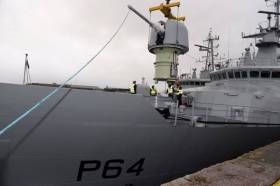Displaying items by tag: Primary Armament
Military Fit-Out Sees Primary Armament Take Shape On Board LÉ George Bernard Shaw
#NavalService - Completion towards the Irish Naval Service newest OPV90 P60 class, LÉ George Bernard Shaw took a notable step forward this week with installation of primary armament at the newbuild's homeport in Cork Harbour, writes Jehan Ashmore.
Crane operations saw the 76mm Oto Melara gun hoisted onto the €67m Offshore Patrol Vessel newbuild (P64) LÉ George Bernard Shaw (that arrived in October) to the Naval Service base on Haulbowline Island. The location is shared with the former East Tip, legacy of the closed (west based) Irish Steel Plant, where waste by-products were transferred for dumping. The site however, as Afloat reported has undergone major remediation works, with plans subject to approval to open a new public park in 2019 (adjacent to the Naval Basin) where the fleet moor up in between patrol duties.
It was within the Naval Basin is where the crane completed its role in lowering the Oto Melara gun carefully into position of the cradle on the bow of LÉ George Bernard Shaw. Oto Melara is a subsidiary of Italian defence manufacturer, Finmeccanica S.p.A. who also supplied the main armoury featured on the trio of P60 class sisters. Likewise of the newbuild, they too were all built in recent years by Babcock Marine in north Devon.
The trio of P60's that cost €199.4m form a particular stage of the vessel replacement modernisation programme within the fleet so far, comprising leadship (P61) LÉ Samuel Beckett commissioned in 2014, (P62) LÉ James Joyce in 2015 and (P63) LÉ William Butler Yeats that entered service in 2016.
According to the Naval Service, work remains on the (P64) LÉ George Bernard Shaw, which is to take place over the coming weeks. This is where the Naval Ordnance Section is tasked to integrate the weapon with the ship's systems as the 2,250 tonnes OPV newbuild works up to Full Operational Capability.
Accommodation of the fourth P60 class is for a crew compliment of 44 personnel and berths though provision in the design also caters for an additional 10 trainees required during particular mission deployments.
As for the naming ceremony of LÉ George Bernard Shaw, coupled with an official commissioning into the Naval Service, Afloat will have more to report as developments take shape likewise of the recent external appearance of the P60 that now looks the part.





























































